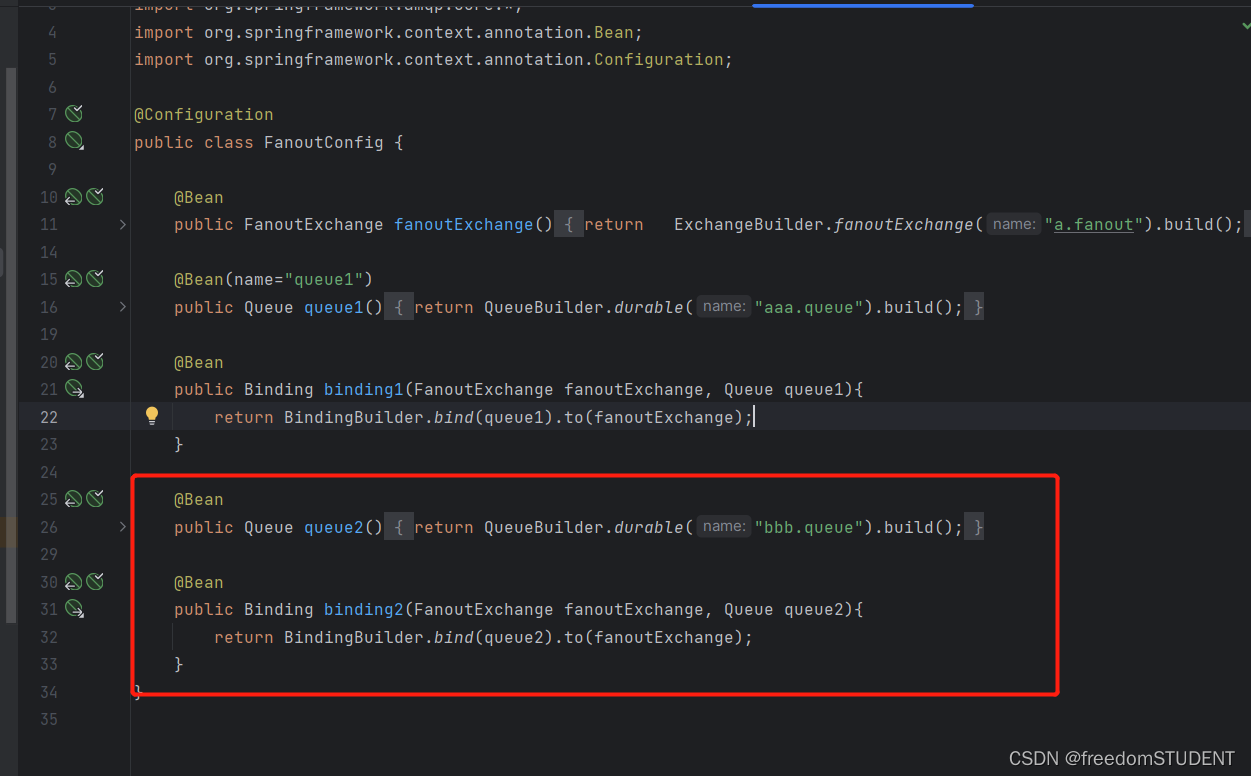【rabbitMQ】声明队列和交换机
2023-12-13 04:53:42
上一篇:springboot整合rabbitMQ模拟简单收发消息
https://blog.csdn.net/m0_67930426/article/details/134904766?spm=1001.2014.3001.5501
相关配置环境参考上篇?
springAMQP提供了几个类用来声明声明队列,交换机及其绑定关系
声明队列,交换机及其绑定都在消费者一端完成
目录
基于Bean声明
Fanout
声明交换机
package com.example.consumer.config;
import org.springframework.amqp.core.FanoutExchange;
import org.springframework.context.annotation.Bean;
import org.springframework.context.annotation.Configuration;
@Configuration
public class FanoutConfig {
@Bean
public FanoutExchange fanoutExchange(){
return new FanoutExchange("a.fanout");
}
}
另一种写法
@Bean
public FanoutExchange fanoutExchange(){
return ExchangeBuilder.fanoutExchange("a.fanout").build();
}
?
声明队列
@Bean
public Queue queue1(){
return new Queue("aaa.queue");
}另一种写法
@Bean
public Queue queue1(){
return QueueBuilder.durable("aaa.queue").build();
}
?
交换机绑定队列
@Bean
public Binding binding1(FanoutExchange fanoutExchange, Queue queue11){
return BindingBuilder.bind(queue1).to(fanoutExchange);
}绑定多个对列
?
代码:
package com.example.consumer.config;
import org.springframework.amqp.core.*;
import org.springframework.context.annotation.Bean;
import org.springframework.context.annotation.Configuration;
@Configuration
public class FanoutConfig {
@Bean
public FanoutExchange fanoutExchange(){
return ExchangeBuilder.fanoutExchange("a.fanout").build();
}
@Bean(name="queue1")
public Queue queue1(){
return QueueBuilder.durable("aaa.queue").build();
}
@Bean
public Binding binding1(FanoutExchange fanoutExchange, Queue queue1){
return BindingBuilder.bind(queue1).to(fanoutExchange);
}
@Bean
public Queue queue2(){
return QueueBuilder.durable("bbb.queue").build();
}
@Bean
public Binding binding2(FanoutExchange fanoutExchange, Queue queue2){
return BindingBuilder.bind(queue2).to(fanoutExchange);
}
}
Direct
声明交换机
package com.example.consumer.config;
import org.springframework.amqp.core.DirectExchange;
import org.springframework.amqp.core.Queue;
import org.springframework.context.annotation.Bean;
import org.springframework.context.annotation.Configuration;
@Configuration
public class DirectConfig {
@Bean
public DirectExchange directExchange(){
return new DirectExchange("b.direct");
}声明队列
@Bean
public Queue queue3(){
return new Queue("ccc.queue");
}
交换机绑定队列
@Bean
public Binding binding3(DirectExchange directExchange, Queue queue3){
return BindingBuilder.bind(queue3).to(directExchange).with("red");
}?以上内容创建了一个a.fanout交换机,创建了一个b.direct交换机
创建了aaa.queue队列,bbb.queue队列,ccc.queue队列
a.fanout绑定了aaa.queue,bbb.queue两个队列,b.direct绑定了ccc.queue队列
并且Routing key: " red "
基于注解声明
在基于Bean声明中,如果要再绑定一个Routing key 需要重新创建一个bean,这样势必会麻烦很多
@RabbitListener(bindings = @QueueBinding(
value =@Queue(name="eee.queue" ,durable = "true"),
exchange =@Exchange(name="eee.direct",type= ExchangeTypes.DIRECT ),
key = {"red","blue"}
))
public void ccc(String msg){
System.out.println("消费者收到了eee.queue的消息:【"+msg+"】");
}
文章来源:https://blog.csdn.net/m0_67930426/article/details/134938095
本文来自互联网用户投稿,该文观点仅代表作者本人,不代表本站立场。本站仅提供信息存储空间服务,不拥有所有权,不承担相关法律责任。 如若内容造成侵权/违法违规/事实不符,请联系我的编程经验分享网邮箱:veading@qq.com进行投诉反馈,一经查实,立即删除!
本文来自互联网用户投稿,该文观点仅代表作者本人,不代表本站立场。本站仅提供信息存储空间服务,不拥有所有权,不承担相关法律责任。 如若内容造成侵权/违法违规/事实不符,请联系我的编程经验分享网邮箱:veading@qq.com进行投诉反馈,一经查实,立即删除!